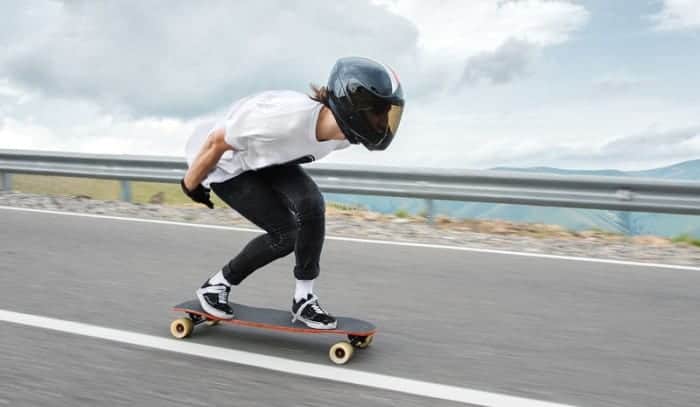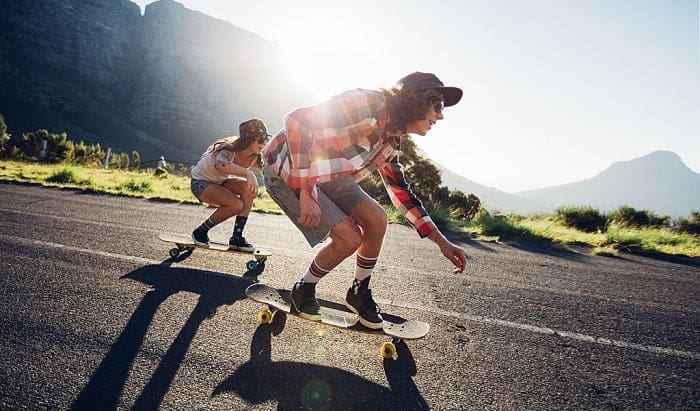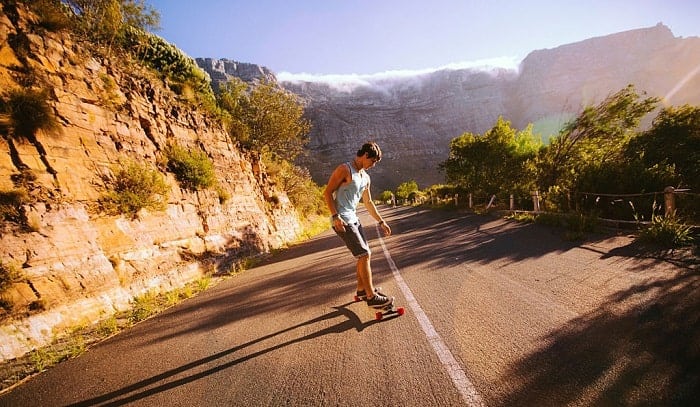Powersliding is a trendy and crucial technique that you would want to learn on your longboard, yet it’s one of the most difficult to master. From the beginning, knowing how to powerslide on a longboard had been a top priority for me, despite the fact that it appeared to be a frightening prospect for a novice.
What is it about understanding how to powerslide that is so essential?
In addition to being visually appealing, it is a key skill for decreasing speed and halting the board. Freeriding and slope boarding are also centered on the skill of powersliding. This technique is also incredibly handy when you’re just relaxing or going to work in heavy traffic.
Powersliding is the act of turning your board at a perfect right angle across the ground, causing your wheels to stop spinning and begin sliding. The friction causes you to lose speed extremely fast, which is a very effective technique to slow down or come to a complete stop.
Table of Contents
What You Need for Powersliding
Even though you can train yourself to longboard powerslide on almost any deck, some equipment and surfaces make it simpler to slide than others.
1. Wheels
Smaller wheels with a tiny patch make it easier to begin a slide than larger wheels with a larger patch.
While stiffer tires are simpler to slide on, you may start to slide on wheels with durometers ranging from 80A and above. It’s also more difficult to learn to slide on wheels that are brand new, so you’ll need to use them out a little before you can start sliding more easily.
2. Deck
A flexible deck will also assist you in learning to slide at a slower speed; however, you may want a firmer board if you decide to go sliding at faster speeds later on.
In order to slide, you need to carve on decks with a higher center of gravity, such as those with top mounts and pintails. This is because they provide greater traction over the wheels, which means you do not have to carve deeply to go into a slide.
Because pintails usually have no inward curvature, they are not recommended for beginners who are starting to slide because their rear foot can get off the deck as they push out (unless there’s really tough grip tape).
You’ll be smarter beginning with a board that has more concave for more stable foot positioning.
3. Terrain
Practice powersliding at a level location that has a slightly inclined route leading into it. You can start approximately ten feet uphill and force your way up the slope, ready to slide as soon as you reach the flat section.
In addition, the wet ground makes it simpler to go into a powerslide since your wheels lose grip more quickly when you ride your board across the surface. Skaters with a lot of expertise typically recommend learning on wet roads since you can slide easier.
However, you should be aware that your bearings may be compromised as a result of the wet surface.
How to Powerslide on the Longboard
Speed Check
If you wish to skate quickly on your board, understanding how to speed check is a critical skill to master. When traveling down slopes, speed monitoring allows you to maintain control over your speed. It’s also a really fashionable motion to be able to perform.
Starting at a slow pace, try shifting your weight to one side, and kicking the board out slightly while doing deep carves. Eventually, you will notice the longboard powerslide wheels produce a twitchy noise as they rotate.
Once you’re okay with sliding while traveling slowly, try traveling a little quicker to see whether you can break traction more easily. Try to keep your board at an angle once you’ve pushed it out and started the longboard drifting.
Speed checks are difficult to master at first because they need full dedication to twisting and leaning while traveling at high speed. A headgear as well as forearm and knee protection will assist you in getting over your anxiety of injury and provide you with the assurance you need to commit to the sport fully.
You should be able to locate a slope that finishes in the grass where you may practice. Then, when you’ve gotten yourself properly outfitted with gear and padding, seek a small, reasonably steep hill to practice your abilities on.
180 Degree Powerslide
This variation is a complete form of the basic stand-up slide, with the fact that you perform a total 180-degree body spin to finish up in a reverse position following the slide.
The swaying movement is larger and the exit step is different. Using a single smooth shoulder rotation action, you spin through the whole slide. Rather than returning your upper body and hips to their original positions once you have finished sliding, you keep on swaying until you are in the opposite direction.
Precautions for Powersliding
If you ask some expert longboarders, they will tell you that learning the powerslide is as easy as one, two, three. However, injuries are possible in this activity, just as they are in any other sport.
Fortunately, there are measures that may be taken to decrease the likelihood of injury. You should be aware of the following safety precautions and warnings before trying to master the powerslide.
Wearing safety gear before skating on a board is mandatory, especially if you are a novice rider with little experience. In general, you’ll want to use padding to protect your forearms, elbows, and knees. It is necessary to wear a high-quality helmet in order to protect your head. Never go longboarding without headgear. It’s unlikely that you’d want to be the victim of a traumatic head injury.
Selecting a practice site should be done with care. Look for a practice place that has grass nearby that you may use. In the event that you do not manage to stop, head towards the grass to limit injury. Concrete sidewalk, as opposed to softer terrains such as grass, has the potential to inflict more serious injuries.
Consider practicing in an area where there are no commuters at all if you are a total newcomer. Begin by training on a level ground or a small incline to get a feel for the technique. Don’t just rush up to the top of a steep incline.
Conclusion
After learning the fundamentals of how to powerslide on a longboard, you may go on to more advanced techniques. It’s quite acceptable to make a few mistakes on your first few efforts; this is typical. It will take a combination of courage and patience to actually master the technique.
It’s also not uncommon to incur a few bruises when learning to powerslide, but the payoff is an indescribable delight when you master your skills for the first time. I hope this guide will help you take that first leap of faith into the world of powersliding and even more stunts.

I am Michael, and I have been enjoying this fun sport for seven years. And nothing is better than having a community to share our passion for those thrilling tricks. I am ready to tell you all I know about skateboarding, showing you how to choose a good board and trick to start and how the practice goes. Stay tuned!




